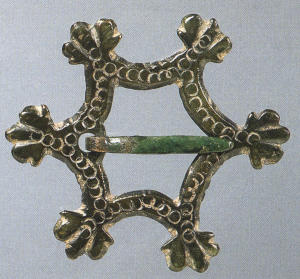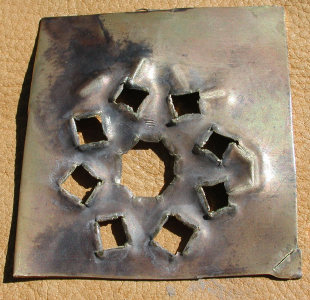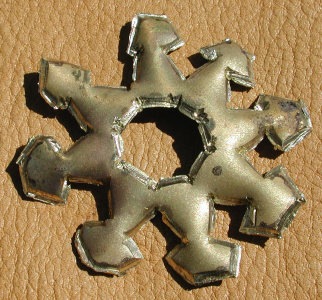The model for my replica is a Hungarian metal-detector find with no provenance. It is 4.8cm in diameter and 1.2mm thick. The pin is missing. It has been chiseled out of sheet copper-alloy, and decorated with punchwork.
Similar star-shaped brooches have been published in Helig and Profaan 1 and 2, with dates from 1325 to 1450. There is a very high-end version in Verona (see Lightbown), dated 1325-1350. The closest match is in the Haedeke collection , which the author dates to the 13th century. It has similar punchwork and terminals, and is similar to the brooch on a statue of Synagogue in Bamberg Cathedral.
Original Replica


Haedeke 195c Synagogue
Construction
Careful observation revealed flanges on some of the edges of the brooch, a product of chisel cutting without complete finish filing. I measured the edges, and determined that two chisel sizes had been used. I did some test cutting, and learned that a soft backing was needed. I used lead sheet.
I traced the original, and transferred the design to brass sheet of a similar thickness to my model. Taking a stout hammer, I spent some time cutting. It took me less than 45 minutes for this, my first attempt. I'm sure that I would get faster with practice.



After removing the star from the sheet brass, I hammered it flat and did a quick clean-up with files. I then applied the decoration, punching circles over the body of the brooch with a nail-set, as per Theopilus' directions:
"A tool is also shaped in the same way but is slender at the end. A hole is impressed in the end by another more slender tool and it is filed all around , so that a very delicate circle appears when it is stuck on gold or silver or gilded copper. "
I used one of the chisels to cut lines in the star tips. Finally, I polished the brooch with modern tools, drilled a hole, and added a sharpened brass wire pin.
